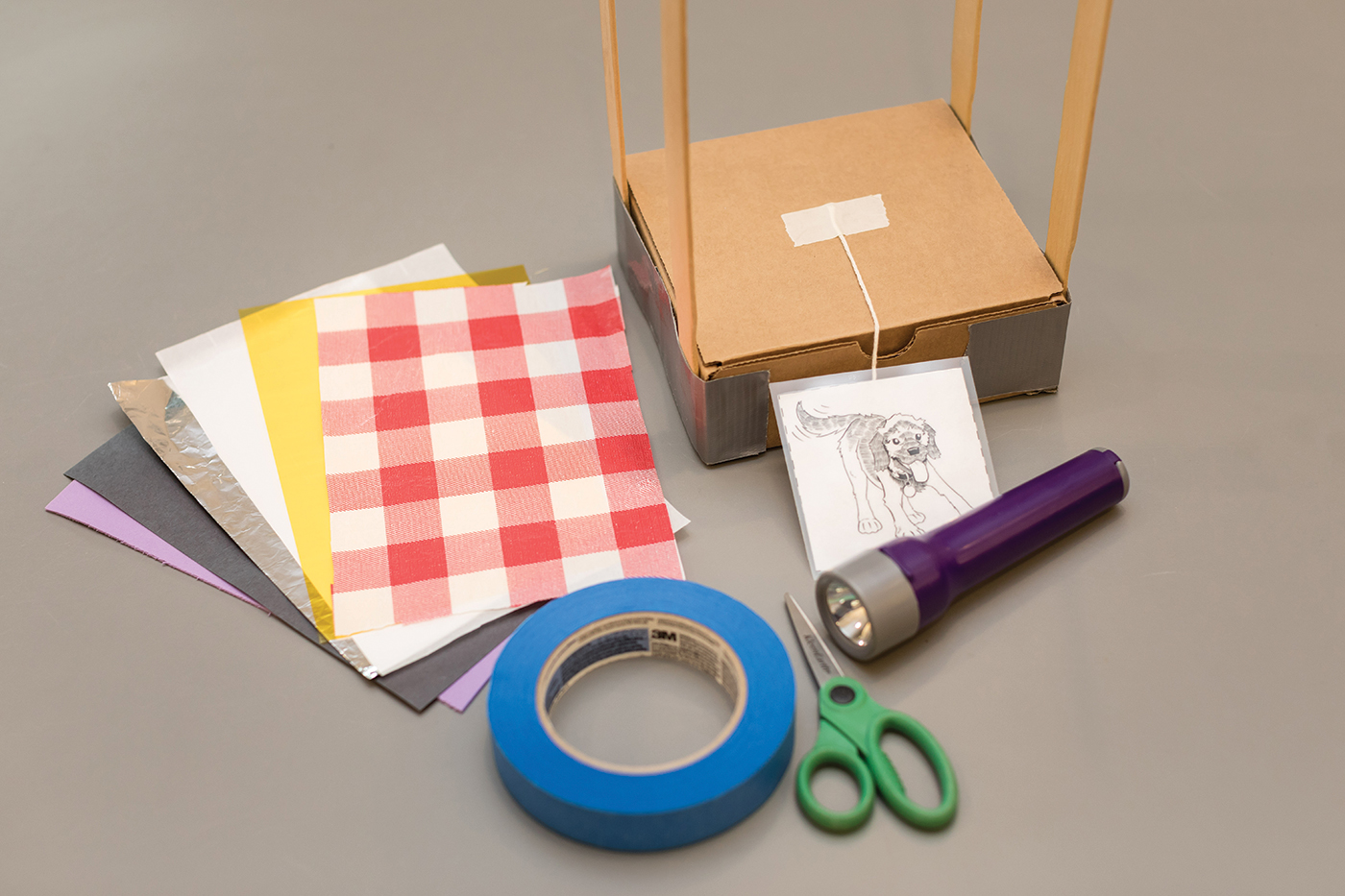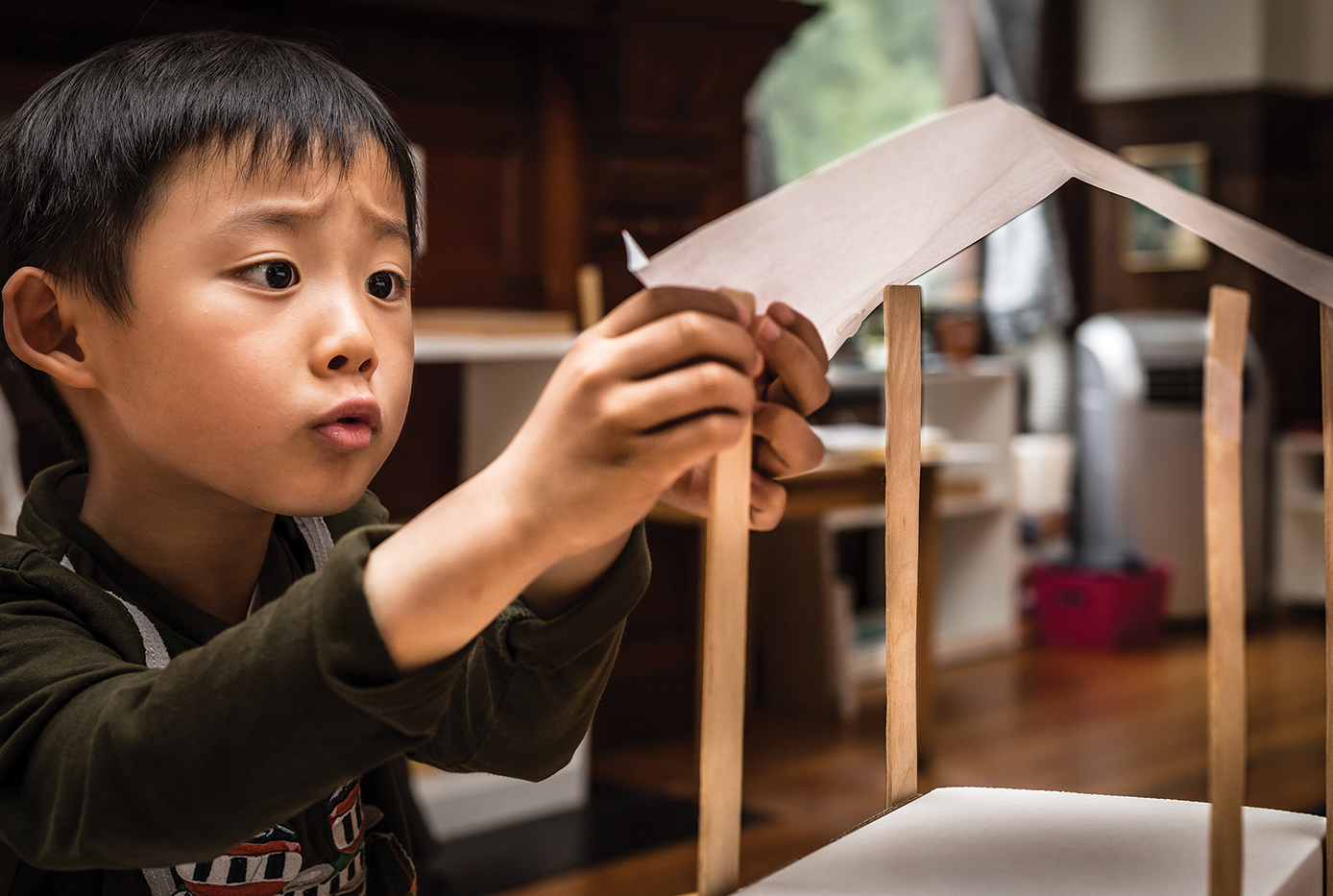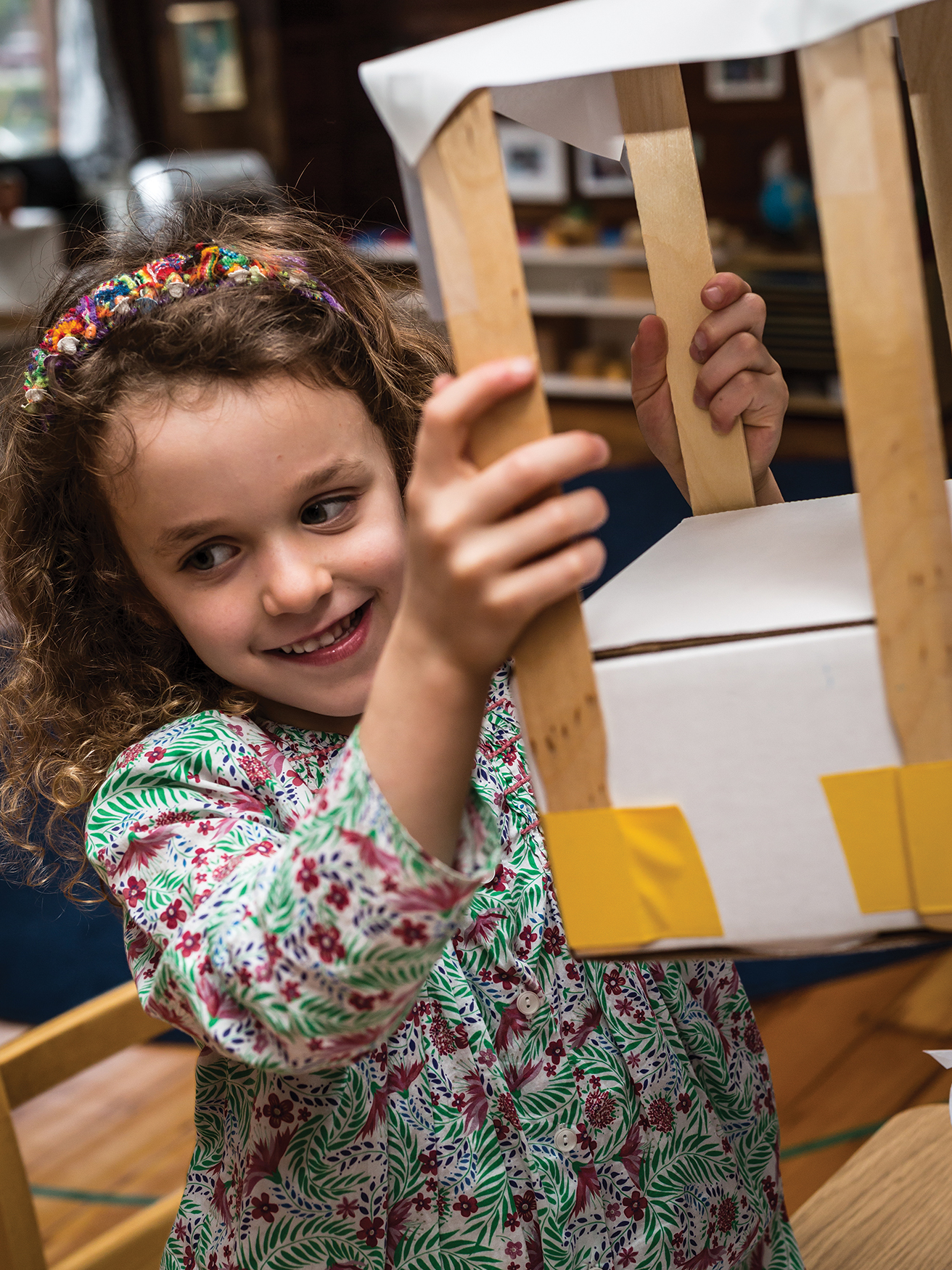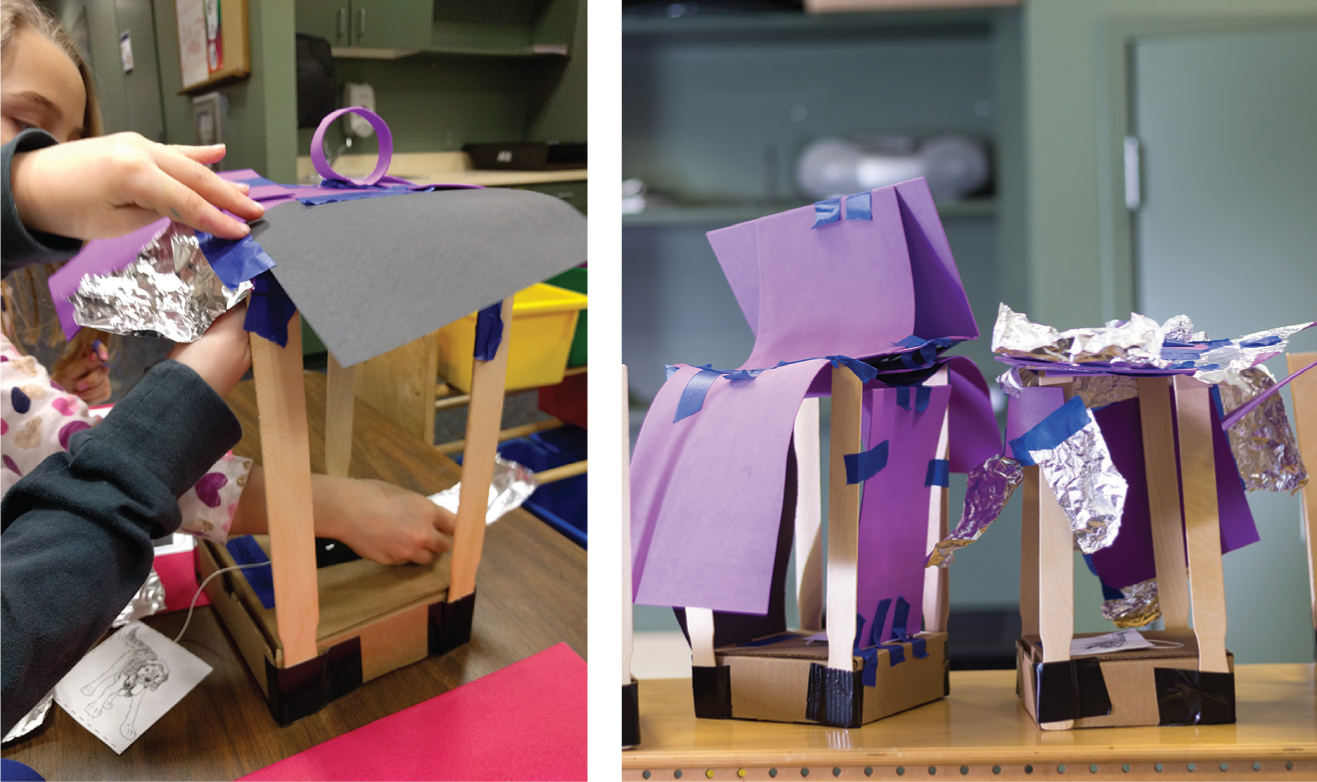Methods and Strategies
A Focus on Function
An early childhood engineering activity helps students think about the way things work.
Science and Children—October 2019 (Volume 57, Issue 3)
By Marisa Garcia, Christine Gentry, Elissa Jordan, Bekka Nolan, and Christine M. Cunningham
This column provides ideas and techniques to enhance your science teaching.
In a kindergarten classroom in Massachusetts, a teacher poses an engineering challenge developed at the Museum of Science, Boston, to her students: Design a shelter to protect a fictional dog, Penny, from getting too warm in the sunlight. They will create shelter roofs and test them using a flashlight, shining light down on a drawing of Penny attached to a string—a makeshift leash (Figure 1). In the days before this engineering challenge, students engaged in shared experiences around light and shadow, feeling and discussing the relative warmth and coolness. Before they begin the day’s engineering lesson, Ms. Benjamin asks questions to review the problem and criteria for solving it.

Ms. Benjamin: What does your shelter need to do?
Alexa: Keep Penny cool.
Ms. Benjamin: And?
Alexa: Protect her from the sunlight.
Ms. Benjamin: So there has to be shade. What else?
Noah: She has to be able to move around and play.
In engineering, we can push even our youngest learners to think critically and create something that reflects the function of the real thing. When children create, they often make a representation of something—a crayon-drawn stick-figure family or a butterfly life cycle represented with pasta—that is based on appearance. Their questions and ideas related to these types of activities focus on appearance. Does the pasta chosen for the butterfly look like a butterfly’s wings? In the classroom engineering excerpt above, the teacher and students focus on what a creation is supposed to do (i.e., how it functions) instead of how it looks (i.e., its form). The questions and ideas that stem from an engineering activity are grounded in a meaningful context and focused on function. Ms. Benjamin asks, “What does your shelter need to do?” This is what makes engineering in early childhood remarkable. In this article, we will demonstrate the relationship between a focus on function and positive outcomes of engineering.
When students engineer, they focus on whether their creation functions to solve the given problem or doesn’t, regardless of how it might look. The result of engineering is a technology—any thing, system, or process that an engineer designs to solve a problem (Engineering is Elementary 2018). Throughout time, educational theorists like Dewey, Montessori, Piaget, and Erikson have all noted how early learners benefit immensely from engaging in real-world activities (Mooney 2013). Engineering is one way to support children’s development and bring real-world problem solving into the early childhood classroom. By engaging children in engineering to make a functional technology, we create a powerful experience for young learners, one that can help them think critically and learn to problem solve in the real world.
Looking at examples from a real kindergarten classroom, we see how engineering, with an intentional focus on function, can spark student motivation; deepen their understanding of science, technology, and the engineered world; promote agency and independence; and encourage creative thinking and innovation.
Enhancing Learning Through Engineering
Sparking Motivation
Hands-on learning can be highly motivating, especially when student creations actually work. In engineering, students create and evaluate their technologies iteratively, meaning they continuously test their designs to see if they work and make changes based on the results. Students are invested in their creations when they are provided the time and space for iterative testing. If a design fails, the desire to improve it and make it functional encourages children to persevere. When students finish an engineering challenge, this motivation is rewarded as they gain a sense of accomplishment. We see such student engagement in the kindergartners who, working with a partner, create different shelter roof shapes and sizes and test them with a flashlight to determine whether the roof makes enough shade for Penny.


Eva: Look how much we’re doing! Penny will be so cool.
Levi: Look what I made.
Ms. Benjamin: Gimme five! (Indicating it’s time to stop working.)
Sarina: Please say it’s not time.
Ms. Benjamin: It’s a short day.
Sarina: But we’re not done.
These students enthusiastically test their roof designs to help Penny. When the teacher tells them it’s time to stop, they want to continue working. They are invested in Penny’s problem and motivated to create a functional shelter to help her.
Engineering provides an opportunity to foster intrinsic motivation. When designing for someone who they care about (Penny), children are driven to help. “Students connect to the engineering contexts or to the clients who will benefit from the solutions, can see the potential impact of their efforts, and come to care about the impacts of their technologies” (Cunningham 2018, p. 16). As students work to create a technology that functions, the iterative process of engineering and their innate desire to help others motivate them to persevere through challenges and achieve success.
Deepening Science Understanding
When students create a technology with the goal of making it function, they gain a deeper understanding of science, technology, and the engineered world. Students are able to better internalize the why behind scientific phenomena (such as shadows and shade) because they are engaging with the phenomena in real time and applying it to a physical roof design that either works or does not. As students engineer, misconceptions can be uncovered and addressed, as in the following example.
Ms. Benjamin: What about the red plastic?
Delilah: It’s not that it’s pretty when the Sun goes through it, it’s that the Sun bounces off.
[Delilah places the red plastic into a pile of materials they have decided “work well” to make shade for Penny.]
Emma: Penny looked pink when you shined on it.
Ms. Benjamin: Does that mean light is going through?
Emma: No.
Delilah: Yes.
In this anecdote, the students grapple with a big science understanding: how light interacts with different materials. Even though Delilah thought that the cellophane (red plastic) was “pretty,” she still tried to use scientific reasoning to support her choice. Emma points out an important observation: that “Penny looked pink” when the light shone through the red plastic. The teacher encourages students to think critically when she asks whether the pink color meant that the light was going through. Although the students respond differently, this conversation has unearthed important information about the science knowledge and potential misconceptions held by each student. The teacher can use this to decide whether students need to revisit or engage in further investigation of important science concepts related to the engineering problem. This particular activity may expand into further exploration around light, shadow, and shade.
Promoting Agency and Independence
In engineering, students have agency to turn their ideas into reality. Creating something that really works on the first attempt is rare; as noted above, engineering involves iteration. By focusing on function, students can confidently evaluate whether their design is successful. Using age-appropriate testing procedures with easily observable results can lead to greater independence as students need not rely on the teacher to assess their work. The main goal is for students to be able to identify a successful design. In engineering, students think critically as they independently evaluate their technologies and take agency over improvements.
The kindergarten students work in pairs, collaborating to plan, create, test, and improve a shelter. Because the students have previously tested the roof size, shape, and materials, they can make informed decisions about their plan without teacher intervention. Students then use their plan to make their design a reality, working together to create, test, and improve the shelter roof. The test for success is simple and straightforward: shining a flashlight over the shelter and observing if Penny has enough shade to play comfortably while on her leash. These students are working to find areas where the light is shining through the roof so they can cover the gaps with strips of foam (Figure 2).

At the culmination of their first engineering project, the kindergarteners observe the various shelter designs, and share their inspirations for improvements and future projects with the class:
Ms. Benjamin: What gave you a new idea?
Sarina: So using two different materials, and also I would use more foam.
Joel: One of them has walls, on that one (points to a shelter). Also, I would make a slanted roof.
Eva: Maybe I could start making walls kind of like (gestures with hands), so they go to the ceiling.
Ezra: I want to do mine again but take off the pointy roof.…It’s not really helping. It looks like a…
Adam: It doesn’t matter how it looks.
Ms. Benjamin: Does it help with shade?
Ezra: It doesn’t really help.
These young learners have not only benefitted from engaging in engineering, they have also been inspired to continue improving and problem solving beyond the close of the unit.
Encouraging children to engineer a technology that really works to solve a problem is beneficial in many ways. The students’ responses indicate they are motivated to continue the process, use their scientific understanding about shade and shapes, take agency in their work, and think critically and creatively to generate a variety of innovative improvements. As Adam says, “It doesn’t matter how it looks!” but rather what it can do. As young learners embark on engineering challenges, encourage them to think beyond just what their technologies look like to how their technologies function.


